NBHS1104: Clinical Reasoning and Nursing Process Integration Report
VerifiedAdded on 2022/11/18
|14
|3473
|363
Report
AI Summary
This report provides a comprehensive analysis of clinical reasoning and its critical integration within the nursing process. It begins by defining clinical reasoning and emphasizing its significance in healthcare, highlighting how it impacts decision-making, patient outcomes, and the overall quality of care. The report then explores the nursing process, outlining its various stages, including assessment, diagnosis, planning, implementation, and evaluation. A significant portion of the report focuses on the clinical reasoning cycle, detailing its steps and how nurses utilize it to gather information, analyze patient conditions, identify problems, set goals, implement interventions, and evaluate outcomes. Furthermore, the report discusses the importance of clinical reasoning abilities for nurses, emphasizing that a lack of these abilities may result in inaccurate or inadequate healthcare. The report also provides practical examples of how clinical reasoning is applied in real-world nursing scenarios and discusses the impact of clinical reasoning in providing quality patient care. Overall, the report underscores the necessity of integrating clinical reasoning into nursing practice to improve patient outcomes and promote a safe healthcare environment.
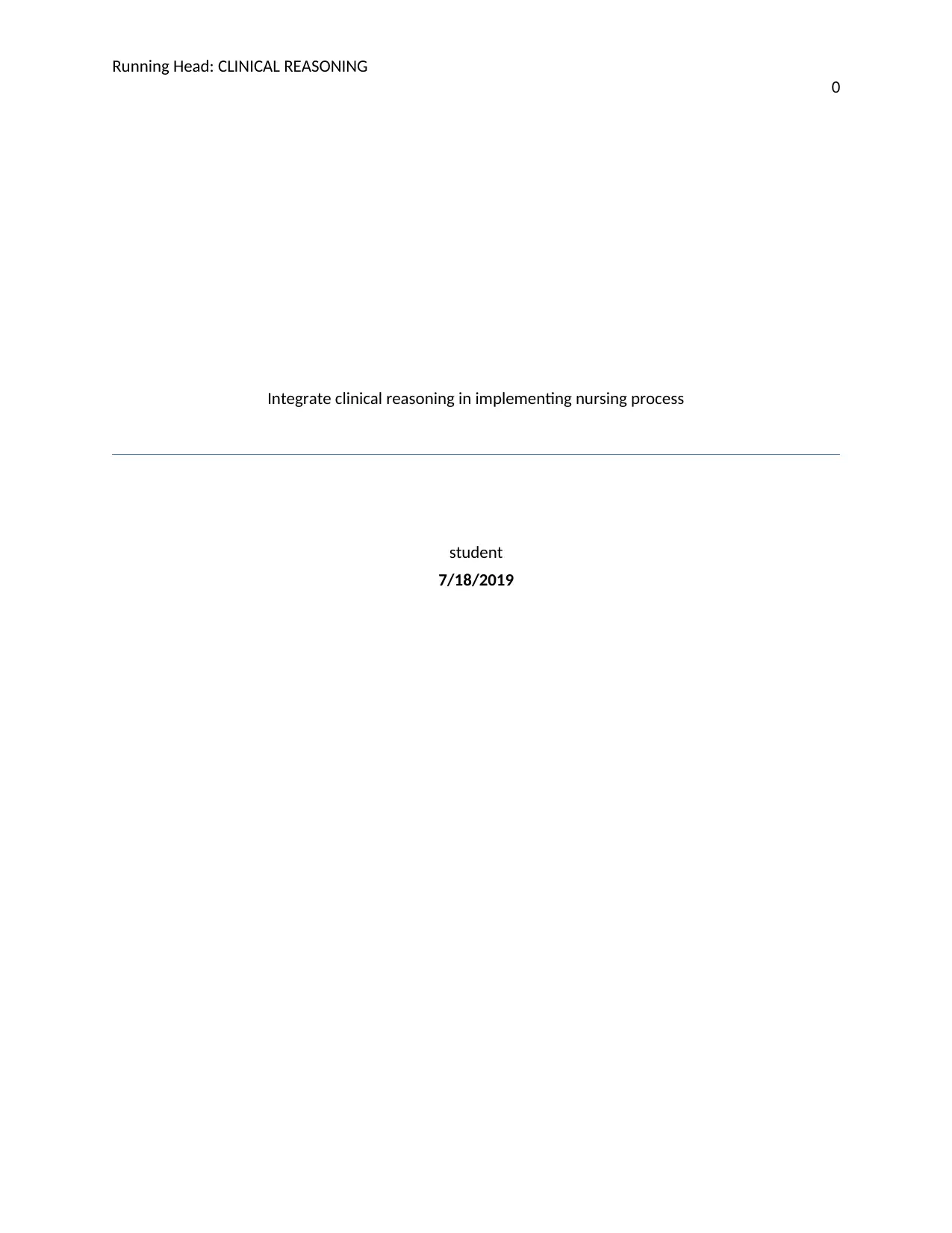
Running Head: CLINICAL REASONING
0
Integrate clinical reasoning in implementing nursing process
student
7/18/2019
0
Integrate clinical reasoning in implementing nursing process
student
7/18/2019
Paraphrase This Document
Need a fresh take? Get an instant paraphrase of this document with our AI Paraphraser
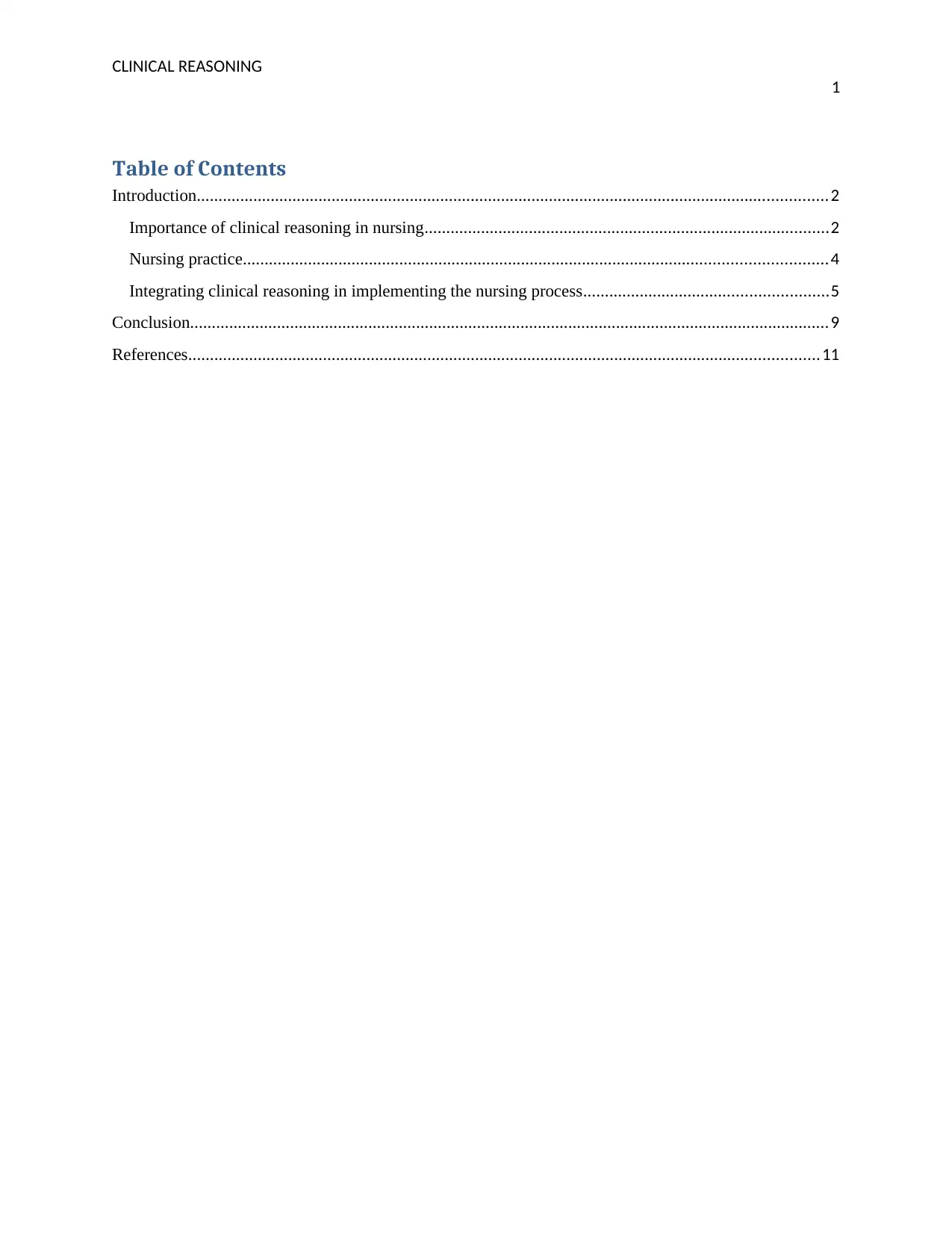
CLINICAL REASONING
1
Table of Contents
Introduction.................................................................................................................................................2
Importance of clinical reasoning in nursing.............................................................................................2
Nursing practice......................................................................................................................................4
Integrating clinical reasoning in implementing the nursing process........................................................5
Conclusion...................................................................................................................................................9
References.................................................................................................................................................11
1
Table of Contents
Introduction.................................................................................................................................................2
Importance of clinical reasoning in nursing.............................................................................................2
Nursing practice......................................................................................................................................4
Integrating clinical reasoning in implementing the nursing process........................................................5
Conclusion...................................................................................................................................................9
References.................................................................................................................................................11
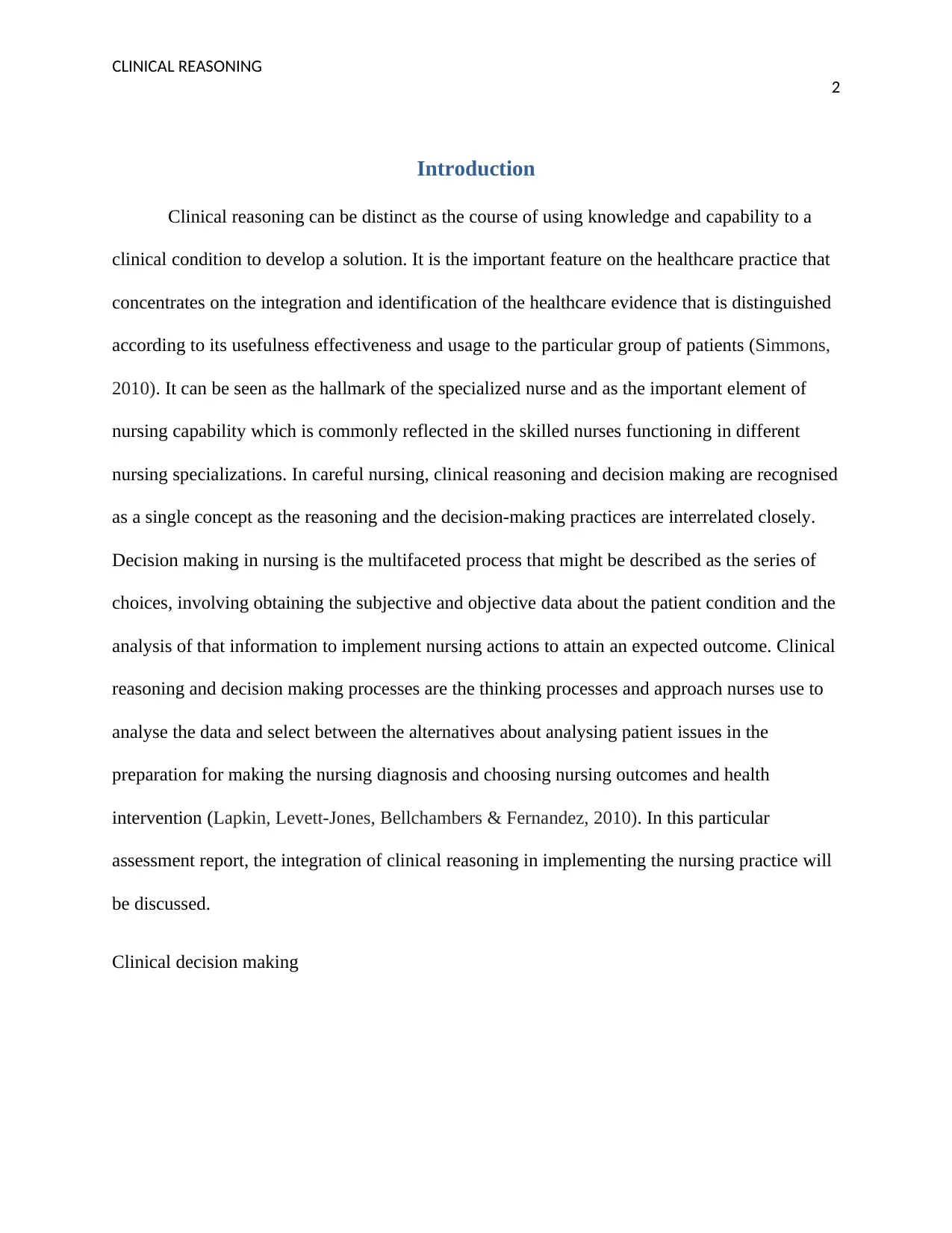
CLINICAL REASONING
2
Introduction
Clinical reasoning can be distinct as the course of using knowledge and capability to a
clinical condition to develop a solution. It is the important feature on the healthcare practice that
concentrates on the integration and identification of the healthcare evidence that is distinguished
according to its usefulness effectiveness and usage to the particular group of patients (Simmons,
2010). It can be seen as the hallmark of the specialized nurse and as the important element of
nursing capability which is commonly reflected in the skilled nurses functioning in different
nursing specializations. In careful nursing, clinical reasoning and decision making are recognised
as a single concept as the reasoning and the decision-making practices are interrelated closely.
Decision making in nursing is the multifaceted process that might be described as the series of
choices, involving obtaining the subjective and objective data about the patient condition and the
analysis of that information to implement nursing actions to attain an expected outcome. Clinical
reasoning and decision making processes are the thinking processes and approach nurses use to
analyse the data and select between the alternatives about analysing patient issues in the
preparation for making the nursing diagnosis and choosing nursing outcomes and health
intervention (Lapkin, Levett-Jones, Bellchambers & Fernandez, 2010). In this particular
assessment report, the integration of clinical reasoning in implementing the nursing practice will
be discussed.
Clinical decision making
2
Introduction
Clinical reasoning can be distinct as the course of using knowledge and capability to a
clinical condition to develop a solution. It is the important feature on the healthcare practice that
concentrates on the integration and identification of the healthcare evidence that is distinguished
according to its usefulness effectiveness and usage to the particular group of patients (Simmons,
2010). It can be seen as the hallmark of the specialized nurse and as the important element of
nursing capability which is commonly reflected in the skilled nurses functioning in different
nursing specializations. In careful nursing, clinical reasoning and decision making are recognised
as a single concept as the reasoning and the decision-making practices are interrelated closely.
Decision making in nursing is the multifaceted process that might be described as the series of
choices, involving obtaining the subjective and objective data about the patient condition and the
analysis of that information to implement nursing actions to attain an expected outcome. Clinical
reasoning and decision making processes are the thinking processes and approach nurses use to
analyse the data and select between the alternatives about analysing patient issues in the
preparation for making the nursing diagnosis and choosing nursing outcomes and health
intervention (Lapkin, Levett-Jones, Bellchambers & Fernandez, 2010). In this particular
assessment report, the integration of clinical reasoning in implementing the nursing practice will
be discussed.
Clinical decision making
⊘ This is a preview!⊘
Do you want full access?
Subscribe today to unlock all pages.

Trusted by 1+ million students worldwide

CLINICAL REASONING
3
Importance of clinical reasoning in nursing
The clinical reasoning practice includes a gathering of cues, handling of the information,
understanding patient’s' issues or situation, planning and implementing the nursing intervention,
evaluation of results and reflect on and learn from the practice. The importance of examining for
evidence, evaluating fundamental concepts and identifying implication is still considered as
essential to the current clinical nursing practice (Alfaro-LeFevre, 2015).
To handle the complicated medical situations efficiently and positively, a thorough
knowledge of the medical reasoning process is very essential, as it can determine the expected
result of the care delivered to the diseased person (Johnsen, Slettebø & Fossum, 2016). Lack of
clinical reasoning abilities frequently fails to provide accurate or acceptable health care. With the
help of clinical-reasoning abilities, perfect patient care can come intuitively, enhancing the
likelihood of advance quality of patient care. Nurses or physicians with no or poor clinical
reasoning might place the health condition of the patient at risk of worsening and death in many
of cases. The benefit of applying clinical reasoning involves performing timely diagnosis,
disease management plans, evading needless investigations which decreases the medication cost
for the diseased person. This ultimately improves the health condition of the patient. Failure to
appropriately diagnose, unsuccessfulness to the institute proper treatment, and improper
management of the patient’s complication are associated with a lack of effective clinical
reasoning skills. For example, clinical practice knowledgeable nurses involve in the manifold
clinical reasoning events for every patient in their health care (Koharchik, Caputi, Robb &
Culleiton, 2015). When they enter the patient's room and instantly observe essential data,
concludes the diseased person and begins proper care. Due to their understanding, skills, and
knowledge, the experienced nurse might seem to accomplish these practices in a manner that
3
Importance of clinical reasoning in nursing
The clinical reasoning practice includes a gathering of cues, handling of the information,
understanding patient’s' issues or situation, planning and implementing the nursing intervention,
evaluation of results and reflect on and learn from the practice. The importance of examining for
evidence, evaluating fundamental concepts and identifying implication is still considered as
essential to the current clinical nursing practice (Alfaro-LeFevre, 2015).
To handle the complicated medical situations efficiently and positively, a thorough
knowledge of the medical reasoning process is very essential, as it can determine the expected
result of the care delivered to the diseased person (Johnsen, Slettebø & Fossum, 2016). Lack of
clinical reasoning abilities frequently fails to provide accurate or acceptable health care. With the
help of clinical-reasoning abilities, perfect patient care can come intuitively, enhancing the
likelihood of advance quality of patient care. Nurses or physicians with no or poor clinical
reasoning might place the health condition of the patient at risk of worsening and death in many
of cases. The benefit of applying clinical reasoning involves performing timely diagnosis,
disease management plans, evading needless investigations which decreases the medication cost
for the diseased person. This ultimately improves the health condition of the patient. Failure to
appropriately diagnose, unsuccessfulness to the institute proper treatment, and improper
management of the patient’s complication are associated with a lack of effective clinical
reasoning skills. For example, clinical practice knowledgeable nurses involve in the manifold
clinical reasoning events for every patient in their health care (Koharchik, Caputi, Robb &
Culleiton, 2015). When they enter the patient's room and instantly observe essential data,
concludes the diseased person and begins proper care. Due to their understanding, skills, and
knowledge, the experienced nurse might seem to accomplish these practices in a manner that
Paraphrase This Document
Need a fresh take? Get an instant paraphrase of this document with our AI Paraphraser

CLINICAL REASONING
4
appears involuntary or instinctive. This particular skill is important when seen against the
background of the enhancing number of negative patient outcome and increasing healthcare
objections. For nurse teaching and education provision, the phases of clinical reasoning might be
integrated into training periods to deliberate the clinical conclusions and decision making
throughout a care intercession and implementing the ‘nursing process' inpatient care (Gerber,
Thevoz & Ramelet, 2015). Simulated nursing backgrounds are a perfect educational method to
challenge the medical decision-making process and clinical reasoning abilities. Most of the
Nurses have continuous attendance on the hospital ward level, delivering the observing and
making conclusions practice the clinical reasoning meets all shifts over a deceased person's
hospital admission. Replying to multifaceted and time serious events needs sophisticated skills
which develop further than strong theoretical understanding, for example evaluating and replying
to clinical worsening (Langridge, Roberts & Pope, 2016).
Nursing practice
The Practice Rational Care Model exemplifies that the focus of nursing processes in the
health care establishments are its patients. It is authoritative that the nurses need to develop the
relationship by therapeutic interaction and performing nursing skills and processes proficiently.
Clinical reasoning is an exact appearance that denotes to the nurses' method of thinking about the
patient anxieties (Kuiper, Pesut & Arms, 2016). The influence of patients’ favourable outcomes
depends on how the nurses are active in clinical reasoning and place it into the action upon
medical decision making happens. Therefore, nurses with deprived clinical reasoning abilities
often fail to understand and notice the patient deteriorating situation, thus mistaken decision
making rises that result in ineffectual patient upkeep and increasing patients suffering. The
clinical decision instead signifies on the consequence after the series of clinical reasoning. Inside
4
appears involuntary or instinctive. This particular skill is important when seen against the
background of the enhancing number of negative patient outcome and increasing healthcare
objections. For nurse teaching and education provision, the phases of clinical reasoning might be
integrated into training periods to deliberate the clinical conclusions and decision making
throughout a care intercession and implementing the ‘nursing process' inpatient care (Gerber,
Thevoz & Ramelet, 2015). Simulated nursing backgrounds are a perfect educational method to
challenge the medical decision-making process and clinical reasoning abilities. Most of the
Nurses have continuous attendance on the hospital ward level, delivering the observing and
making conclusions practice the clinical reasoning meets all shifts over a deceased person's
hospital admission. Replying to multifaceted and time serious events needs sophisticated skills
which develop further than strong theoretical understanding, for example evaluating and replying
to clinical worsening (Langridge, Roberts & Pope, 2016).
Nursing practice
The Practice Rational Care Model exemplifies that the focus of nursing processes in the
health care establishments are its patients. It is authoritative that the nurses need to develop the
relationship by therapeutic interaction and performing nursing skills and processes proficiently.
Clinical reasoning is an exact appearance that denotes to the nurses' method of thinking about the
patient anxieties (Kuiper, Pesut & Arms, 2016). The influence of patients’ favourable outcomes
depends on how the nurses are active in clinical reasoning and place it into the action upon
medical decision making happens. Therefore, nurses with deprived clinical reasoning abilities
often fail to understand and notice the patient deteriorating situation, thus mistaken decision
making rises that result in ineffectual patient upkeep and increasing patients suffering. The
clinical decision instead signifies on the consequence after the series of clinical reasoning. Inside
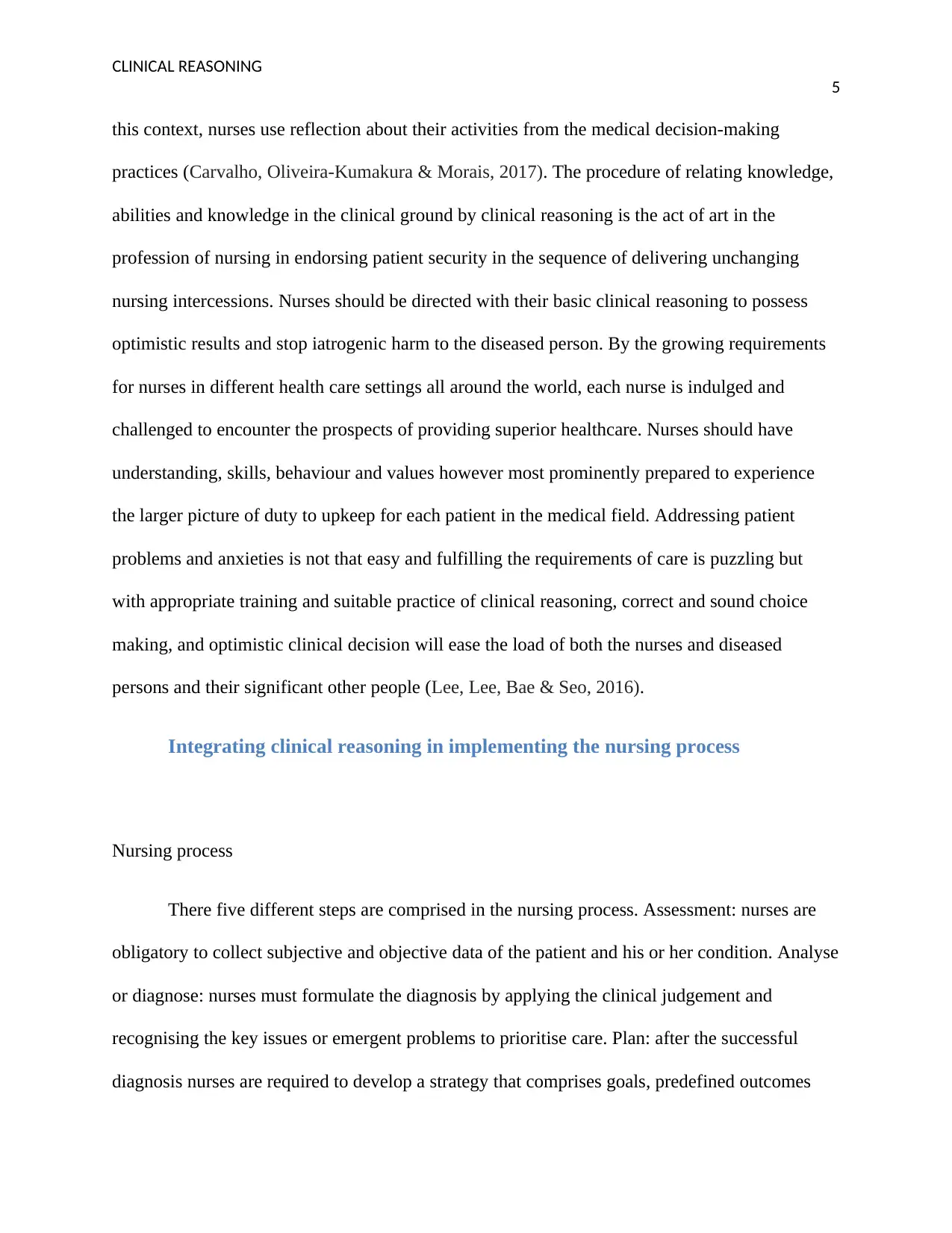
CLINICAL REASONING
5
this context, nurses use reflection about their activities from the medical decision-making
practices (Carvalho, Oliveira-Kumakura & Morais, 2017). The procedure of relating knowledge,
abilities and knowledge in the clinical ground by clinical reasoning is the act of art in the
profession of nursing in endorsing patient security in the sequence of delivering unchanging
nursing intercessions. Nurses should be directed with their basic clinical reasoning to possess
optimistic results and stop iatrogenic harm to the diseased person. By the growing requirements
for nurses in different health care settings all around the world, each nurse is indulged and
challenged to encounter the prospects of providing superior healthcare. Nurses should have
understanding, skills, behaviour and values however most prominently prepared to experience
the larger picture of duty to upkeep for each patient in the medical field. Addressing patient
problems and anxieties is not that easy and fulfilling the requirements of care is puzzling but
with appropriate training and suitable practice of clinical reasoning, correct and sound choice
making, and optimistic clinical decision will ease the load of both the nurses and diseased
persons and their significant other people (Lee, Lee, Bae & Seo, 2016).
Integrating clinical reasoning in implementing the nursing process
Nursing process
There five different steps are comprised in the nursing process. Assessment: nurses are
obligatory to collect subjective and objective data of the patient and his or her condition. Analyse
or diagnose: nurses must formulate the diagnosis by applying the clinical judgement and
recognising the key issues or emergent problems to prioritise care. Plan: after the successful
diagnosis nurses are required to develop a strategy that comprises goals, predefined outcomes
5
this context, nurses use reflection about their activities from the medical decision-making
practices (Carvalho, Oliveira-Kumakura & Morais, 2017). The procedure of relating knowledge,
abilities and knowledge in the clinical ground by clinical reasoning is the act of art in the
profession of nursing in endorsing patient security in the sequence of delivering unchanging
nursing intercessions. Nurses should be directed with their basic clinical reasoning to possess
optimistic results and stop iatrogenic harm to the diseased person. By the growing requirements
for nurses in different health care settings all around the world, each nurse is indulged and
challenged to encounter the prospects of providing superior healthcare. Nurses should have
understanding, skills, behaviour and values however most prominently prepared to experience
the larger picture of duty to upkeep for each patient in the medical field. Addressing patient
problems and anxieties is not that easy and fulfilling the requirements of care is puzzling but
with appropriate training and suitable practice of clinical reasoning, correct and sound choice
making, and optimistic clinical decision will ease the load of both the nurses and diseased
persons and their significant other people (Lee, Lee, Bae & Seo, 2016).
Integrating clinical reasoning in implementing the nursing process
Nursing process
There five different steps are comprised in the nursing process. Assessment: nurses are
obligatory to collect subjective and objective data of the patient and his or her condition. Analyse
or diagnose: nurses must formulate the diagnosis by applying the clinical judgement and
recognising the key issues or emergent problems to prioritise care. Plan: after the successful
diagnosis nurses are required to develop a strategy that comprises goals, predefined outcomes
⊘ This is a preview!⊘
Do you want full access?
Subscribe today to unlock all pages.

Trusted by 1+ million students worldwide
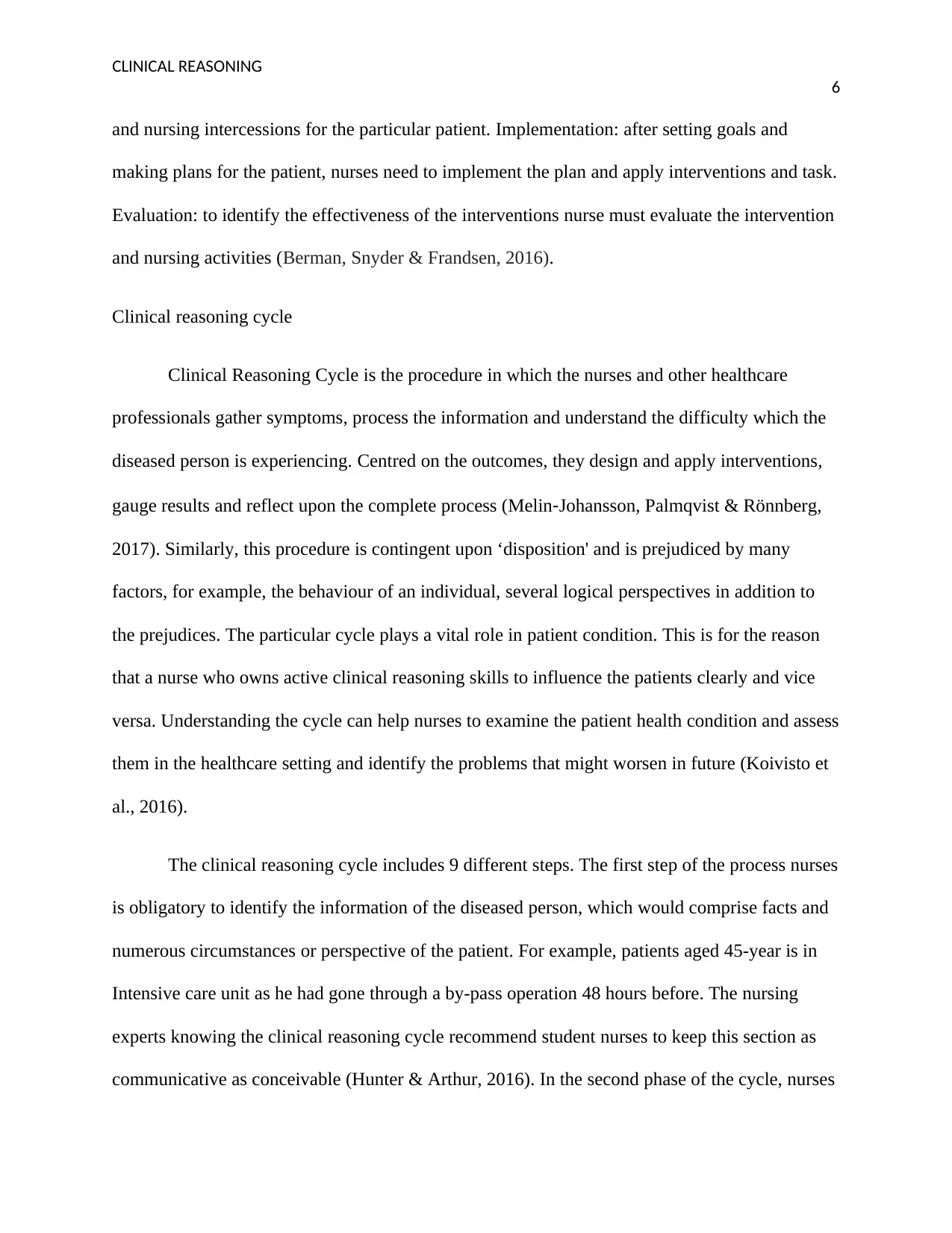
CLINICAL REASONING
6
and nursing intercessions for the particular patient. Implementation: after setting goals and
making plans for the patient, nurses need to implement the plan and apply interventions and task.
Evaluation: to identify the effectiveness of the interventions nurse must evaluate the intervention
and nursing activities (Berman, Snyder & Frandsen, 2016).
Clinical reasoning cycle
Clinical Reasoning Cycle is the procedure in which the nurses and other healthcare
professionals gather symptoms, process the information and understand the difficulty which the
diseased person is experiencing. Centred on the outcomes, they design and apply interventions,
gauge results and reflect upon the complete process (Melin‐Johansson, Palmqvist & Rönnberg,
2017). Similarly, this procedure is contingent upon ‘disposition' and is prejudiced by many
factors, for example, the behaviour of an individual, several logical perspectives in addition to
the prejudices. The particular cycle plays a vital role in patient condition. This is for the reason
that a nurse who owns active clinical reasoning skills to influence the patients clearly and vice
versa. Understanding the cycle can help nurses to examine the patient health condition and assess
them in the healthcare setting and identify the problems that might worsen in future (Koivisto et
al., 2016).
The clinical reasoning cycle includes 9 different steps. The first step of the process nurses
is obligatory to identify the information of the diseased person, which would comprise facts and
numerous circumstances or perspective of the patient. For example, patients aged 45-year is in
Intensive care unit as he had gone through a by-pass operation 48 hours before. The nursing
experts knowing the clinical reasoning cycle recommend student nurses to keep this section as
communicative as conceivable (Hunter & Arthur, 2016). In the second phase of the cycle, nurses
6
and nursing intercessions for the particular patient. Implementation: after setting goals and
making plans for the patient, nurses need to implement the plan and apply interventions and task.
Evaluation: to identify the effectiveness of the interventions nurse must evaluate the intervention
and nursing activities (Berman, Snyder & Frandsen, 2016).
Clinical reasoning cycle
Clinical Reasoning Cycle is the procedure in which the nurses and other healthcare
professionals gather symptoms, process the information and understand the difficulty which the
diseased person is experiencing. Centred on the outcomes, they design and apply interventions,
gauge results and reflect upon the complete process (Melin‐Johansson, Palmqvist & Rönnberg,
2017). Similarly, this procedure is contingent upon ‘disposition' and is prejudiced by many
factors, for example, the behaviour of an individual, several logical perspectives in addition to
the prejudices. The particular cycle plays a vital role in patient condition. This is for the reason
that a nurse who owns active clinical reasoning skills to influence the patients clearly and vice
versa. Understanding the cycle can help nurses to examine the patient health condition and assess
them in the healthcare setting and identify the problems that might worsen in future (Koivisto et
al., 2016).
The clinical reasoning cycle includes 9 different steps. The first step of the process nurses
is obligatory to identify the information of the diseased person, which would comprise facts and
numerous circumstances or perspective of the patient. For example, patients aged 45-year is in
Intensive care unit as he had gone through a by-pass operation 48 hours before. The nursing
experts knowing the clinical reasoning cycle recommend student nurses to keep this section as
communicative as conceivable (Hunter & Arthur, 2016). In the second phase of the cycle, nurses
Paraphrase This Document
Need a fresh take? Get an instant paraphrase of this document with our AI Paraphraser
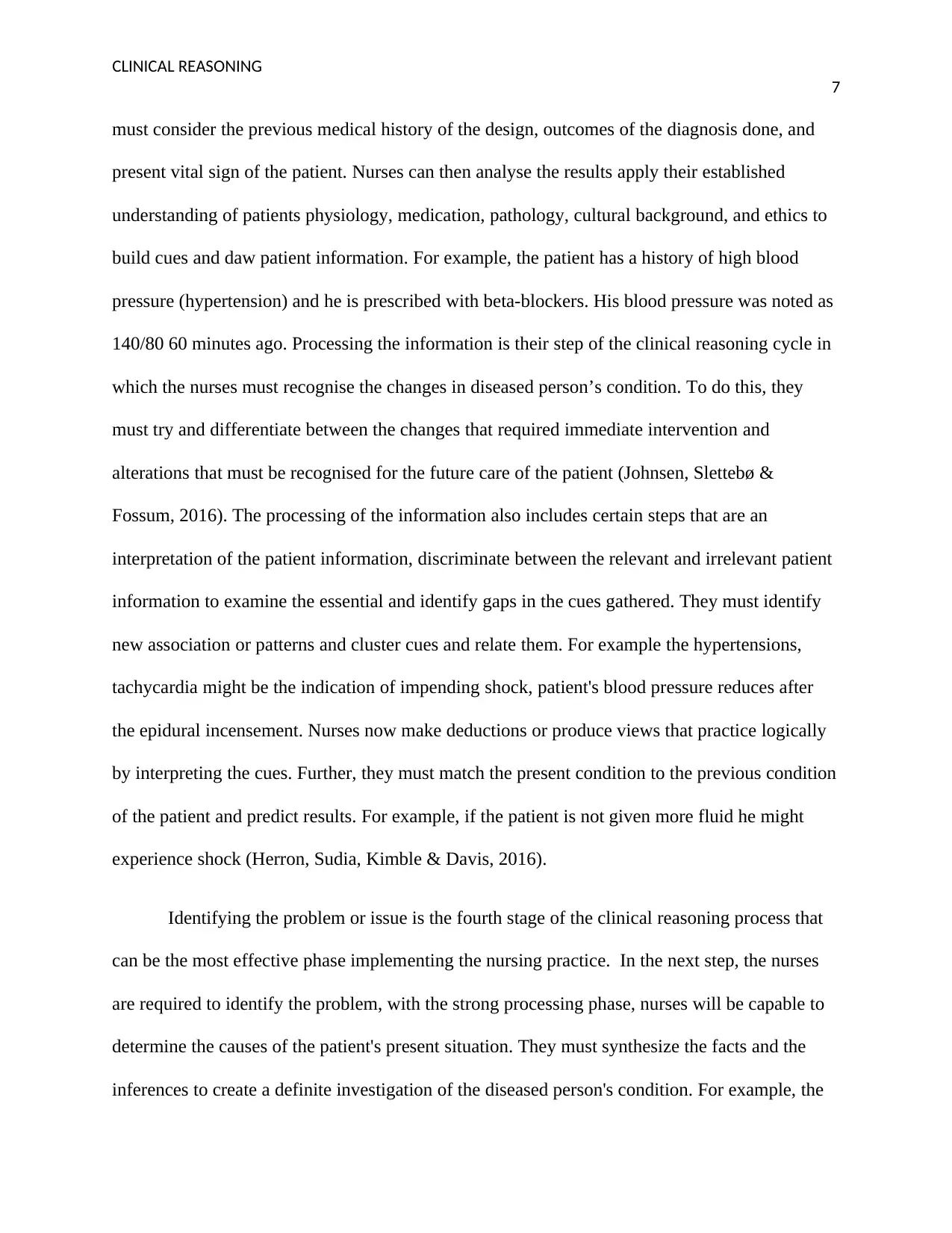
CLINICAL REASONING
7
must consider the previous medical history of the design, outcomes of the diagnosis done, and
present vital sign of the patient. Nurses can then analyse the results apply their established
understanding of patients physiology, medication, pathology, cultural background, and ethics to
build cues and daw patient information. For example, the patient has a history of high blood
pressure (hypertension) and he is prescribed with beta-blockers. His blood pressure was noted as
140/80 60 minutes ago. Processing the information is their step of the clinical reasoning cycle in
which the nurses must recognise the changes in diseased person’s condition. To do this, they
must try and differentiate between the changes that required immediate intervention and
alterations that must be recognised for the future care of the patient (Johnsen, Slettebø &
Fossum, 2016). The processing of the information also includes certain steps that are an
interpretation of the patient information, discriminate between the relevant and irrelevant patient
information to examine the essential and identify gaps in the cues gathered. They must identify
new association or patterns and cluster cues and relate them. For example the hypertensions,
tachycardia might be the indication of impending shock, patient's blood pressure reduces after
the epidural incensement. Nurses now make deductions or produce views that practice logically
by interpreting the cues. Further, they must match the present condition to the previous condition
of the patient and predict results. For example, if the patient is not given more fluid he might
experience shock (Herron, Sudia, Kimble & Davis, 2016).
Identifying the problem or issue is the fourth stage of the clinical reasoning process that
can be the most effective phase implementing the nursing practice. In the next step, the nurses
are required to identify the problem, with the strong processing phase, nurses will be capable to
determine the causes of the patient's present situation. They must synthesize the facts and the
inferences to create a definite investigation of the diseased person's condition. For example, the
7
must consider the previous medical history of the design, outcomes of the diagnosis done, and
present vital sign of the patient. Nurses can then analyse the results apply their established
understanding of patients physiology, medication, pathology, cultural background, and ethics to
build cues and daw patient information. For example, the patient has a history of high blood
pressure (hypertension) and he is prescribed with beta-blockers. His blood pressure was noted as
140/80 60 minutes ago. Processing the information is their step of the clinical reasoning cycle in
which the nurses must recognise the changes in diseased person’s condition. To do this, they
must try and differentiate between the changes that required immediate intervention and
alterations that must be recognised for the future care of the patient (Johnsen, Slettebø &
Fossum, 2016). The processing of the information also includes certain steps that are an
interpretation of the patient information, discriminate between the relevant and irrelevant patient
information to examine the essential and identify gaps in the cues gathered. They must identify
new association or patterns and cluster cues and relate them. For example the hypertensions,
tachycardia might be the indication of impending shock, patient's blood pressure reduces after
the epidural incensement. Nurses now make deductions or produce views that practice logically
by interpreting the cues. Further, they must match the present condition to the previous condition
of the patient and predict results. For example, if the patient is not given more fluid he might
experience shock (Herron, Sudia, Kimble & Davis, 2016).
Identifying the problem or issue is the fourth stage of the clinical reasoning process that
can be the most effective phase implementing the nursing practice. In the next step, the nurses
are required to identify the problem, with the strong processing phase, nurses will be capable to
determine the causes of the patient's present situation. They must synthesize the facts and the
inferences to create a definite investigation of the diseased person's condition. For example, the

CLINICAL REASONING
8
patient is hypovolemic and blood pressure has been worsened due to epidural as the results of
vasodilation (Gurbutt & Carty, 2018). This particular step can help nurses to prevent serious
situations and identify the deteriorating patient. Most of the steps of nursing practice and clinical
reasoning cycles are similar. For example in the fifth step of the cycle nurses must establish
goals and identify what they want to happen in case of the patient, expected outcome, and the
time frame in which the treatment process takes place. For instance, the nurse wants to set the
goals for the patient that they need to improve the haemodynamic status of the patient, improve
the blood pressure issues, and stabilise the urine output. Taking appropriate action is the key skill
of the efficient nurses, as it is their responsibilities to take expected action that is obtainable
because these actions can help in achieving the outcomes expected before the treatment process.
For example, repeating blood pressure, assessment of abdominal condition, bowel, skin integrity,
and other factors. In case of any adverse situation, the nurses will call the physician to get
command to increase a patient's IV rate and administer aramine is required (Carvalho, Oliveira-
Kumakura, & Morais, 2017).
Evaluation is the second last step in the clinical-reasoning process. The nursing role is not
simply confined efficacious nursing carefulness to the diseased person. It is also essential to
evaluate the effectiveness of expected outcomes and actions. This can be done by asking the
patient like has the condition is improved or not. For example, the patient's blood pressure is up
for now however nurses will require assessing the patient f he needs medication layer.
Reflecting on the clinical process and fresh learning is the last stage of the clinical reasoning
process (Kuiper, Pesut, & Arms, 2016). The nurse must reflect upon what they have gained
throughout the process of patient care. It similarly includes discussing the things that could have
learnt by the nurses if they would perform differently. This also includes a nurse's ability to learn
8
patient is hypovolemic and blood pressure has been worsened due to epidural as the results of
vasodilation (Gurbutt & Carty, 2018). This particular step can help nurses to prevent serious
situations and identify the deteriorating patient. Most of the steps of nursing practice and clinical
reasoning cycles are similar. For example in the fifth step of the cycle nurses must establish
goals and identify what they want to happen in case of the patient, expected outcome, and the
time frame in which the treatment process takes place. For instance, the nurse wants to set the
goals for the patient that they need to improve the haemodynamic status of the patient, improve
the blood pressure issues, and stabilise the urine output. Taking appropriate action is the key skill
of the efficient nurses, as it is their responsibilities to take expected action that is obtainable
because these actions can help in achieving the outcomes expected before the treatment process.
For example, repeating blood pressure, assessment of abdominal condition, bowel, skin integrity,
and other factors. In case of any adverse situation, the nurses will call the physician to get
command to increase a patient's IV rate and administer aramine is required (Carvalho, Oliveira-
Kumakura, & Morais, 2017).
Evaluation is the second last step in the clinical-reasoning process. The nursing role is not
simply confined efficacious nursing carefulness to the diseased person. It is also essential to
evaluate the effectiveness of expected outcomes and actions. This can be done by asking the
patient like has the condition is improved or not. For example, the patient's blood pressure is up
for now however nurses will require assessing the patient f he needs medication layer.
Reflecting on the clinical process and fresh learning is the last stage of the clinical reasoning
process (Kuiper, Pesut, & Arms, 2016). The nurse must reflect upon what they have gained
throughout the process of patient care. It similarly includes discussing the things that could have
learnt by the nurses if they would perform differently. This also includes a nurse's ability to learn
⊘ This is a preview!⊘
Do you want full access?
Subscribe today to unlock all pages.

Trusted by 1+ million students worldwide
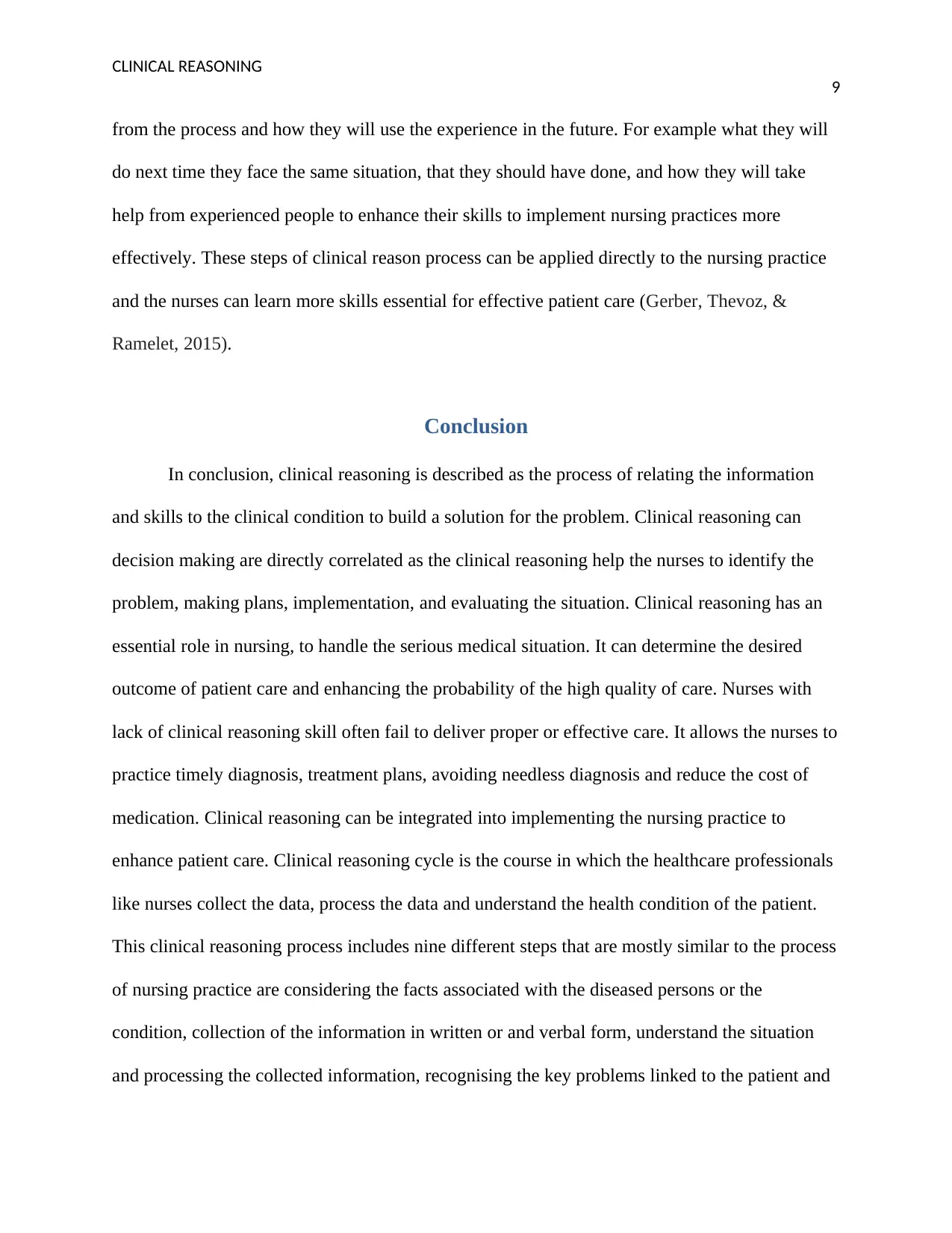
CLINICAL REASONING
9
from the process and how they will use the experience in the future. For example what they will
do next time they face the same situation, that they should have done, and how they will take
help from experienced people to enhance their skills to implement nursing practices more
effectively. These steps of clinical reason process can be applied directly to the nursing practice
and the nurses can learn more skills essential for effective patient care (Gerber, Thevoz, &
Ramelet, 2015).
Conclusion
In conclusion, clinical reasoning is described as the process of relating the information
and skills to the clinical condition to build a solution for the problem. Clinical reasoning can
decision making are directly correlated as the clinical reasoning help the nurses to identify the
problem, making plans, implementation, and evaluating the situation. Clinical reasoning has an
essential role in nursing, to handle the serious medical situation. It can determine the desired
outcome of patient care and enhancing the probability of the high quality of care. Nurses with
lack of clinical reasoning skill often fail to deliver proper or effective care. It allows the nurses to
practice timely diagnosis, treatment plans, avoiding needless diagnosis and reduce the cost of
medication. Clinical reasoning can be integrated into implementing the nursing practice to
enhance patient care. Clinical reasoning cycle is the course in which the healthcare professionals
like nurses collect the data, process the data and understand the health condition of the patient.
This clinical reasoning process includes nine different steps that are mostly similar to the process
of nursing practice are considering the facts associated with the diseased persons or the
condition, collection of the information in written or and verbal form, understand the situation
and processing the collected information, recognising the key problems linked to the patient and
9
from the process and how they will use the experience in the future. For example what they will
do next time they face the same situation, that they should have done, and how they will take
help from experienced people to enhance their skills to implement nursing practices more
effectively. These steps of clinical reason process can be applied directly to the nursing practice
and the nurses can learn more skills essential for effective patient care (Gerber, Thevoz, &
Ramelet, 2015).
Conclusion
In conclusion, clinical reasoning is described as the process of relating the information
and skills to the clinical condition to build a solution for the problem. Clinical reasoning can
decision making are directly correlated as the clinical reasoning help the nurses to identify the
problem, making plans, implementation, and evaluating the situation. Clinical reasoning has an
essential role in nursing, to handle the serious medical situation. It can determine the desired
outcome of patient care and enhancing the probability of the high quality of care. Nurses with
lack of clinical reasoning skill often fail to deliver proper or effective care. It allows the nurses to
practice timely diagnosis, treatment plans, avoiding needless diagnosis and reduce the cost of
medication. Clinical reasoning can be integrated into implementing the nursing practice to
enhance patient care. Clinical reasoning cycle is the course in which the healthcare professionals
like nurses collect the data, process the data and understand the health condition of the patient.
This clinical reasoning process includes nine different steps that are mostly similar to the process
of nursing practice are considering the facts associated with the diseased persons or the
condition, collection of the information in written or and verbal form, understand the situation
and processing the collected information, recognising the key problems linked to the patient and
Paraphrase This Document
Need a fresh take? Get an instant paraphrase of this document with our AI Paraphraser
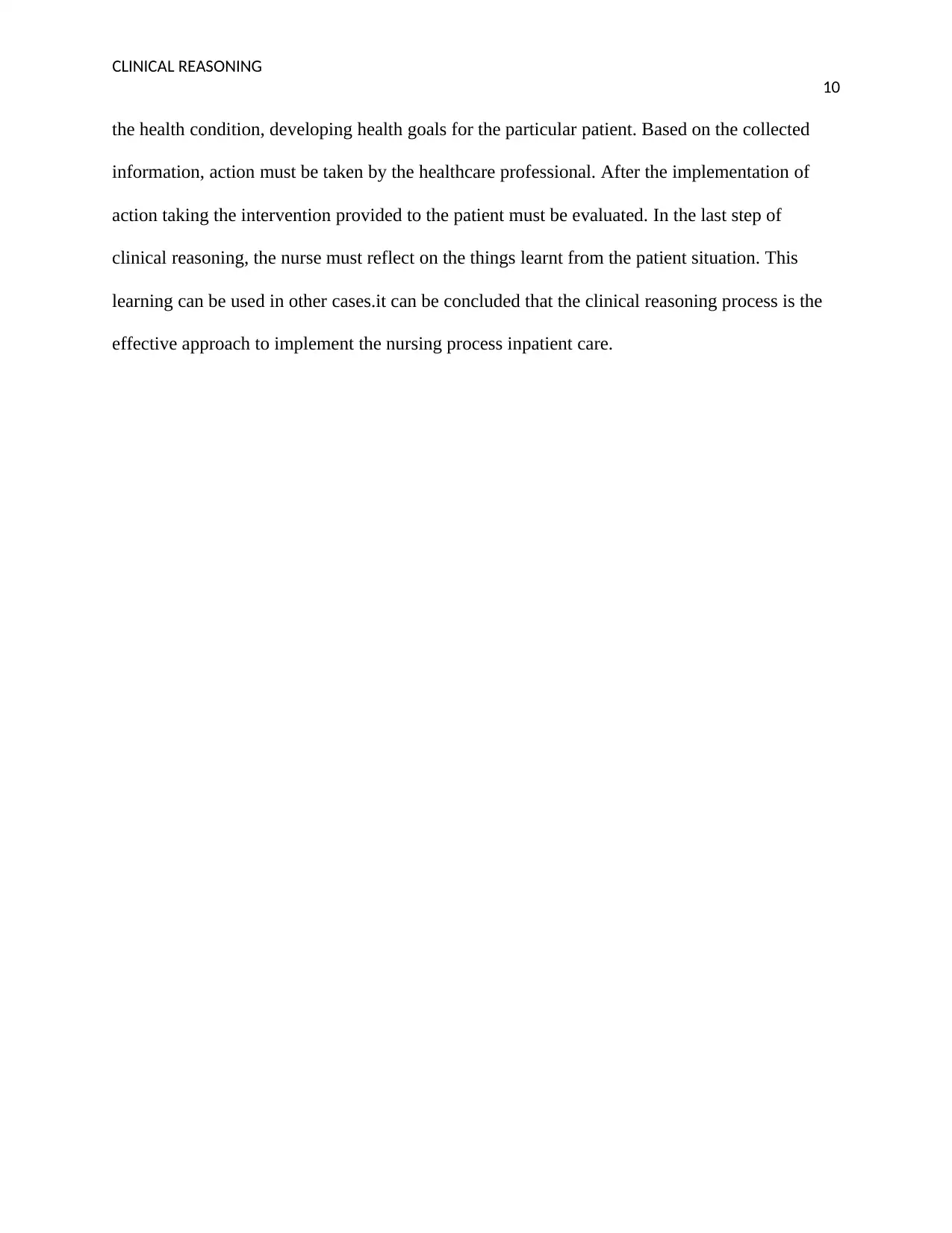
CLINICAL REASONING
10
the health condition, developing health goals for the particular patient. Based on the collected
information, action must be taken by the healthcare professional. After the implementation of
action taking the intervention provided to the patient must be evaluated. In the last step of
clinical reasoning, the nurse must reflect on the things learnt from the patient situation. This
learning can be used in other cases.it can be concluded that the clinical reasoning process is the
effective approach to implement the nursing process inpatient care.
10
the health condition, developing health goals for the particular patient. Based on the collected
information, action must be taken by the healthcare professional. After the implementation of
action taking the intervention provided to the patient must be evaluated. In the last step of
clinical reasoning, the nurse must reflect on the things learnt from the patient situation. This
learning can be used in other cases.it can be concluded that the clinical reasoning process is the
effective approach to implement the nursing process inpatient care.

CLINICAL REASONING
11
References
Alfaro-LeFevre, R. (2015). Critical Thinking, Clinical Reasoning, and Clinical Judgment E-
Book: A Practical Approach. Elsevier Health Sciences.
Berman, A., Snyder, S., & Frandsen, G. (2016). Kozier & Erb's Fundamentals of Nursing:
Concepts, process and practice. Boston, MA: Pearson.
Carvalho, E. C. D., Oliveira-Kumakura, A. R. D. S., & Morais, S. C. R. V. (2017). Clinical
reasoning in nursing: teaching strategies and assessment tools. Revista brasileira de
enfermagem, 70(3), 662-668.
Forneris, S. G., Neal, D. O., Tiffany, J., Kuehn, M. B., Meyer, H. M., Blazovich, L. M., &
Smerillo, M. (2015). Enhancing clinical reasoning through simulation debriefing: A
multisite study. Nursing Education Perspectives, 36(5), 304-310.
Gerber, A., Thevoz, A. L., & Ramelet, A. S. (2015). Expert clinical reasoning and pain
assessment in mechanically ventilated patients: A descriptive study. Australian Critical
Care, 28(1), 2-8.
Gonzalez, L. (2018). Teaching Clinical Reasoning Piece by Piece: A Clinical Reasoning
Concept-Based Learning Method. Journal of Nursing Education, 57(12), 727-735.
Gurbutt, R., & Carty, A. (2018). Nurses' Clinical Decision Making. Routledge.
Herron, E. K., Sudia, T., Kimble, L. P., & Davis, A. H. (2016). Prelicensure baccalaureate
nursing students' perceptions of their development of clinical reasoning. Journal of
Nursing Education, 55(6), 329-335.
11
References
Alfaro-LeFevre, R. (2015). Critical Thinking, Clinical Reasoning, and Clinical Judgment E-
Book: A Practical Approach. Elsevier Health Sciences.
Berman, A., Snyder, S., & Frandsen, G. (2016). Kozier & Erb's Fundamentals of Nursing:
Concepts, process and practice. Boston, MA: Pearson.
Carvalho, E. C. D., Oliveira-Kumakura, A. R. D. S., & Morais, S. C. R. V. (2017). Clinical
reasoning in nursing: teaching strategies and assessment tools. Revista brasileira de
enfermagem, 70(3), 662-668.
Forneris, S. G., Neal, D. O., Tiffany, J., Kuehn, M. B., Meyer, H. M., Blazovich, L. M., &
Smerillo, M. (2015). Enhancing clinical reasoning through simulation debriefing: A
multisite study. Nursing Education Perspectives, 36(5), 304-310.
Gerber, A., Thevoz, A. L., & Ramelet, A. S. (2015). Expert clinical reasoning and pain
assessment in mechanically ventilated patients: A descriptive study. Australian Critical
Care, 28(1), 2-8.
Gonzalez, L. (2018). Teaching Clinical Reasoning Piece by Piece: A Clinical Reasoning
Concept-Based Learning Method. Journal of Nursing Education, 57(12), 727-735.
Gurbutt, R., & Carty, A. (2018). Nurses' Clinical Decision Making. Routledge.
Herron, E. K., Sudia, T., Kimble, L. P., & Davis, A. H. (2016). Prelicensure baccalaureate
nursing students' perceptions of their development of clinical reasoning. Journal of
Nursing Education, 55(6), 329-335.
⊘ This is a preview!⊘
Do you want full access?
Subscribe today to unlock all pages.

Trusted by 1+ million students worldwide
1 out of 14
Related Documents
Your All-in-One AI-Powered Toolkit for Academic Success.
+13062052269
info@desklib.com
Available 24*7 on WhatsApp / Email
![[object Object]](/_next/static/media/star-bottom.7253800d.svg)
Unlock your academic potential
Copyright © 2020–2025 A2Z Services. All Rights Reserved. Developed and managed by ZUCOL.





